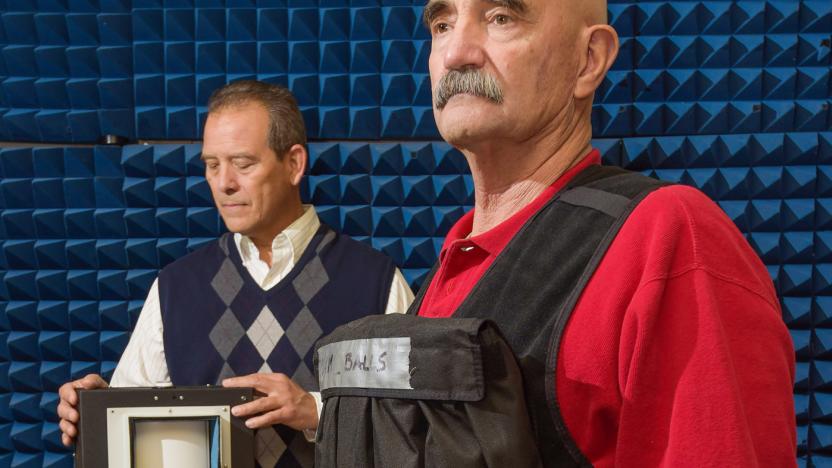SandiaNationalLaboratories
Latest

A real suicide bomb detector should arrive this year
Ever since terrorism became an all-too-real fact of life, people have dreamed of suicide bomb detectors that spot an explosive vest before its wearer has a chance to detonate. However, making a working example has proven elusive. Some companies threw their hands up in frustration after developing systems that just weren't accurate enough. Others, meanwhile, didn't even try that hard -- the UK went so far as to ban some detectors that proved utterly ineffective. At last, though, it looks like a genuinely functional suicide bomb detector is on the horizon.

Folding offshore wind turbines could power 10,000 US homes
The US Department of Energy's plan to generate 20 percent of the nation's electrical power from wind by 2030 is ambitious, to say the least. To pull it off, the turbines will need to be located offshore, where winds are steadier and stronger. However, putting wind turbines in the ocean is also far more expensive, so they need to be enormous in order to make it worthwhile. Researchers from Sandia National Laboraties have come up with a design that features 650-foot blades -- over two football fields long -- that can generate up to 50 megawatts of power.

This ultra-efficient robot walks just like people do
You don't have to worry about robots rising up against humanity anytime soon -- the bipedal ones, at least. When they aren't constantly falling down, two-legged robots are running down their power supplies due to inefficient gaits and wasted motion. During a recent DARPA competition, teams from Sandia National Labs and SRI International squared off to see whose robot could walk the furthest. SRI's robot, dubbed the "DURUS," won out by walking 2.05 kilometers in just over two and a half hours while using just 350 watts of power. For those of us who aren't electrical engineers, that's a really impressive feat. In fact, the DURUS uses up to 30 times less power than the ATLAS robot employed in the DARPA challenge.

Sandia Labs' MegaDroid project simulates 300,000 Android phones to fight wireless catastrophes (video)
We've seen some large-scale simulations, including some that couldn't get larger. Simulated cellular networks are still a rare breed, however, which makes Sandia National Laboratories' MegaDroid project all the more important. The project's cluster of off-the-shelf PCs emulates a town of 300,000 Android phones down to their cellular and GPS behavior, all with the aim of tracing the wider effects of natural disasters, hacking attempts and even simple software bugs. Researchers imagine the eventually public tool set being useful not just for app developers, but for the military and mesh network developers -- the kind who'd need to know how their on-the-field networks are running even when local authorities try to shut them down. MegaDroid is still very much an in-progress effort, although Sandia Labs isn't limiting its scope to Android and can see its work as relevant to iOS or any other platform where a ripple in the network can lead to a tidal wave of problems.

Visualized: Sandia National Laboratories' Z machine erupts in a web of lightning
Sandia National Laboratories' Z machine sounds like it belongs in a James Bond movie more than it does an Alberquerque research facility. Based on what it can do, that's not as far-fetched as it seems. What you see isn't the handiwork of some electric spider -- it's what you witness in the immediate fraction of a second after the Z's electromagnetic pulse kicks in and forks of lightning burst across the 108-foot distance inside. The pulse in question is key to Sandia's studies of fusion and the effect of very intense magnetic pressures on materials that normally refuse to change states. Even in 2006, the Z was putting out pressure more than 10 million times that of the atmosphere, and it successfully melted diamond at roughly half that strength. It goes without saying that we don't want to be anywhere near this kind of energy when scientists flick the switch, but we're glad to see that something so pretty and deadly can help us understand physics. [Image credit: Randy Montoya, Sandia National Laboratories]

Sandia Labs develops self monitoring smart outlet, still needs you to plug it in
The folk at Sandia Labs work on all sorts of interesting projects, and the latest thing to fan our utopian dreams is this experimental smart power outlet. Unlike most monitoring set-ups, it can measure and control electric load without being connected to a central management system. The outlet comprises four receptacles, each with voltage and current sensors and a small computer which shuttles data over an Ethernet bridge. This autonomous style of operation could lead to more intelligent power grids that self-monitor, adapt and integrate with other grids without complex infrastructure updates. Other benefits include removing large points of failure, desirable in any network, and simpler home power monitoring systems. Sandia Labs' prototype could also improve effectiveness of variable output energy sources such as wind and solar, thanks to its ability to compensate for flux in energy production -- which might come in handy.



